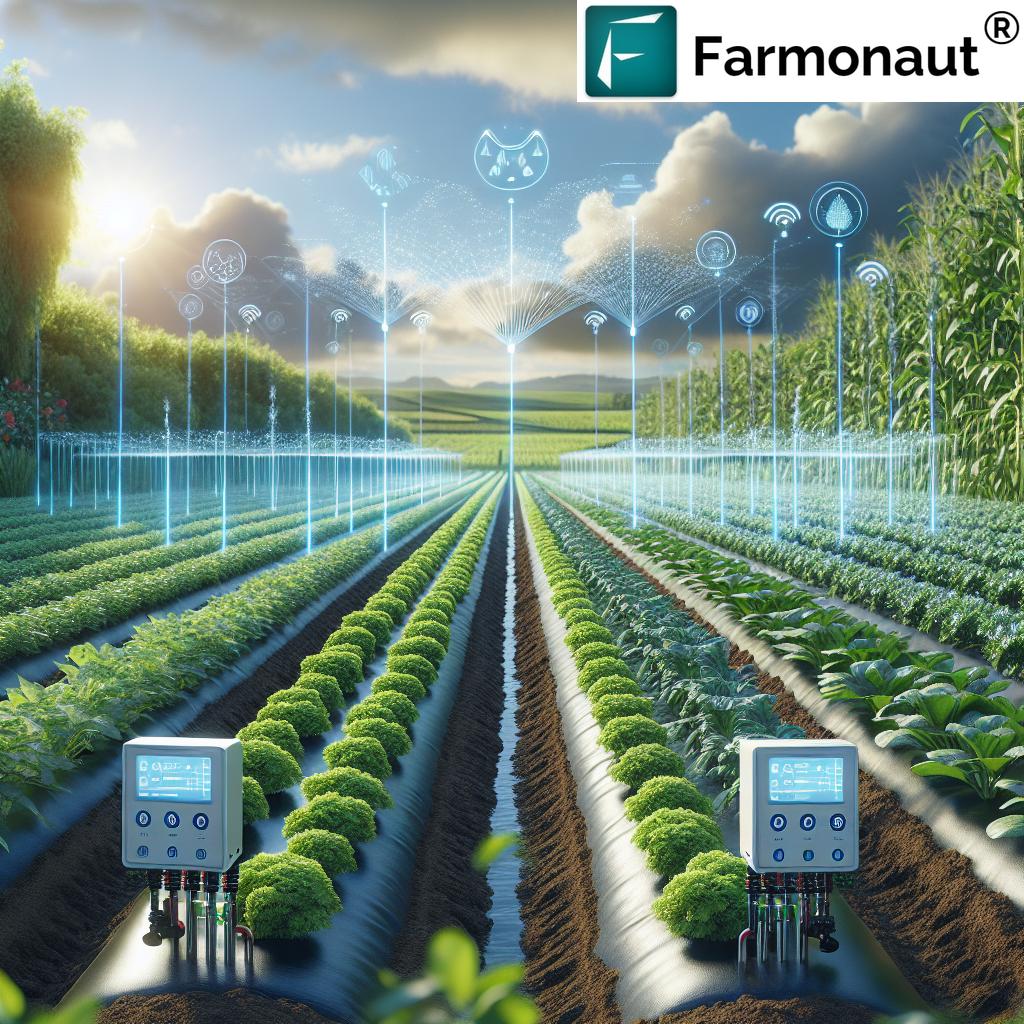Ammonia Into Nitrates: Fertiliser & Poultry Sensor Guide (2025 Innovations Roundup)
Table of Contents
- Introduction: Ammonia’s Cornerstone Role in Agriculture 2025
- Ammonia Into Nitrates: The Process and 2025 Breakthroughs
- Ammonia Nitrate Fertiliser: Modern Use, Safety, and Crop Impact
- Ammonia Sensor for Poultry: Enhancing Animal Welfare and Efficiency
- 2025 Comparative Innovations Table
- Farmonaut’s Satellite Tech for Modern Agriculture
- FAQ: Ammonia into Nitrates, Fertilizers & Sensors – Future Outlook
- Conclusion: Embracing Efficiency & Sustainability in Modern Farming
“By 2025, advanced ammonia sensors can detect poultry house ammonia levels 30% faster than traditional methods.”
Introduction: Ammonia’s Cornerstone Role in Agriculture 2025
In 2025 and beyond, the role of ammonia in agriculture remains more crucial than ever. This compound—in its transformation from ammonia into nitrates—serves as the backbone of modern fertilization practices and animal welfare systems worldwide. Exploring the topics of ammonia nitrate fertiliser and ammonia sensor for poultry reveals how technological innovations are boosting farming efficiency, crop yields, and livestock health.
Advances in soil science and precision agriculture technologies continue to enhance the conversion of ammonia into nitrates, raising both the quantity and quality of food produced by farmers. Ammonium nitrate fertilisers—essential for growth during peak crop phases—are being reformulated with safety, environmental sustainability, and efficiency in mind. Meanwhile, cutting-edge ammonia sensors for poultry help protect animal health, monitoring air composition and enabling smarter farm management.
This guide provides a scientific yet practical overview of these 2025 innovations, spotlighting the biological and chemical processes that underpin modern agriculture. We also highlight how solutions like those we provide at Farmonaut are empowering farmers globally with affordable, accessible, and sophisticated monitoring tools.
Ammonia Into Nitrates: The Process and 2025 Breakthroughs
The Science: Conversion of Ammonia Into Nitrates
Ammonia (NH3) is a fundamental nitrogen source for plants, yet in its raw form, it is not efficiently taken up by most crops.
To become plant-accessible, ammonia must undergo a natural biological and chemical process called nitrification. This conversion relies on:
- Nitrifying bacteria, primarily the Nitrosomonas and Nitrobacter species.
-
Stages:
- Ammonia is oxidized to nitrite (NO2–)
- Nitrite is further oxidized to nitrate (NO3–)
- Nitrate is the final, most accessible form—readily absorbed by crops.
This process is essential for soil fertility and fundamentally underpins the productivity of modern agriculture systems worldwide. The availability of nitrates directly impacts crop yield, nutrient uptake, and product quality, making efficient ammonia into nitrates conversion a top priority for sustainable agriculture in 2025.
2025 Innovations in Ammonia into Nitrates Conversion
- Precision Agriculture Technologies: Real-time sensor networks, satellite imagery, and machine learning now give farmers and agronomists actionable insights into soil nitrogen cycles and conversion dynamics.
- Microbiome Research: Tailored soil amendments and microbial inoculants (beneficial bacteria) are being developed to enhance the activity of nitrifying species like Nitrosomonas and Nitrobacter.
- Advanced Monitoring Systems: Monitoring platforms—like those we offer at Farmonaut—use satellite and AI-driven analytics to track soil health, optimizing ammonia conversion rates and supporting targeted fertilization.
- Water Management Strategies: Controlled irrigation and soil moisture algorithms are proven to reduce the leaching of nitrogen compounds into water bodies, lowering environmental impact.
These advances in conversion technologies are unlocking significant value for farmers worldwide by allowing better management of nutrient cycles, reduced fertilizer application, and minimized greenhouse gas emissions.
Why the Nitrogen Cycle Remains Crucial for 2025’s Food Security
Efficient conversion of ammonia into nitrates is the foundation for agricultural security. Global food supply depends on plant-available nitrogen: without it, yields and quality fall dramatically, making this conversion the cornerstone of modern, high-output farming.
- Reduces Environmental Risks: By fine-tuning ammonia-to-nitrate conversion, we reduce water pollution, lower greenhouse gas emissions, and make fertilizer use more efficient.
- Improves Crop Outcomes: Better nitrate availability ensures improved plant growth, robust root systems, and optimum yields.
- Supports Sustainability: Combining technologies and biological amendments creates sustainable practices while maintaining or increasing crops output.
“New ammonium nitrate fertilisers in 2025 are projected to increase crop nitrogen uptake efficiency by up to 18%.”
Ammonia Nitrate Fertiliser: Modern Use, Safety, and Crop Impact
What Is Ammonia Nitrate Fertiliser?
Ammonia nitrate fertiliser—specifically ammonium nitrate—is a staple in global farming. Produced by combining ammonia (NH3) and nitric acid (HNO3), this compound delivers two forms of plant-available nitrogen:
- Ammonium (NH4+): Supports sustained, gradual plant growth
- Nitrate (NO3–): Provides immediate nitrogen supply for rapid crop development
The dual nutrient forms make ammonium nitrate ideal for peak growth phases and situations where both immediate and prolonged feeding are needed. As of 2025, it remains one of the most widely used fertilizers worldwide due to its high nitrogen content, solubility, and versatility across crops and soils.
2025 Innovations: Improved Safety and Controlled Release
-
Safer Formulations:
- Enhanced granulation and new additives lower the risks of volatility and explosion during storage and handling, while maintaining nutrient efficiency.
- Coated granules and stabilizers reduce accidental ignition and allow better spread and storage safety.
-
Controlled-Release Fertilizers:
- New controlled-release ammonium nitrate delivers nutrients gradually, matching crop demand, and significantly reducing leaching losses and over-fertilization risks.
- Farmers can apply less fertilizer per hectare while maximizing uptake rates, yields, and reducing environmental impacts.
-
Precision Application with Smart Technologies:
- Ammonia sensor-based soil monitoring systems and AI-driven analytics now guide dosage and timing for fertilizer application—all powered by platforms like ours at Farmonaut.
- Data-driven dosing aligns fertilizer use with actual crop nutrient needs, which results in better crop quality and reduced costs.
-
Eco-Friendly Practices:
- With greenhouse gas emissions from fertilization minimized and carbon footprint tracking solutions widely available, sustainability goals are achievable even for large-scale operations.
- Environmental impact analytics help meet regulatory requirements and consumer demand for responsible agriculture production.
Learn more about farm management system solutions for large operations at our Large Scale Farm Management page, where you can access satellite and AI-powered monitoring for all your fields.
Ammonium Nitrate: Still the “Gold Standard” for Yield and Quality
- High stability, solubility, and nutrient value mean ammonium nitrate fertilizer consistently outperforms other nitrogen sources in tough regimes.
- The 2025 range of control-release, safe-handling, and smart-integrated products are tailored for optimized crop cycles and modern compliance standards.
- Improvements in precision agriculture tools—available via Farmonaut’s satellite monitoring app—make monitoring and application easier, safer, and more cost-effective than ever.
Ammonia Sensor for Poultry: Enhancing Animal Welfare and Efficiency
In poultry production, managing air quality is vital—not just for animal welfare, but for worker safety and farm productivity. The ammonia sensor for poultry is a 2025 breakthrough, becoming a standard in smart poultry houses.
Why Monitor Ammonia in Poultry Farming?
- Ammonia (NH3) gas is produced as bird excreta breaks down, especially at high temperatures or moisture.
- At concentrations above 20-25 ppm, ammonia impairs bird health—damaging the respiratory tract, eyes, and immune system.
- Prolonged exposure reduces feed conversion efficiency, growth rates, and egg production—factors directly affecting flock performance.
- For workers, high ammonia air levels are a recognized occupational hazard.
2025 Technologies: Smart Sensors and Automated Systems
- Ammonia sensor for poultry is now more accurate, responsive, and durable than ever—with detection speeds up to 30% faster than older models.
- Digital, wireless sensors alert farmers to unsafe levels, triggering automated ventilation and air filtration systems.
-
IoT & Analytics: Real-time data is sent to cloud platforms (accessible on web, Android, or iOS), integrating with
predictive analytics for proactive maintenance. - Predictive Maintenance: Analytics forecast when ammonia will rise—allowing for timely cleaning, litter changes, or ventilation tweaks before issues arise.
- Enhanced Animal Welfare: Healthier, less-stressed chickens grow faster, require fewer antibiotics, and have lower mortality rates.
We, at Farmonaut, support smart poultry operations with satellite-driven environmental surveillance and resource management tools—boosting the safety, productivity, and sustainability of livestock operations.
Explore our Fleet and Resource Management solutions, designed to help large and small livestock farm managers automate, track, and manage their operations for maximum operational efficiency.
Smart Monitoring: Animal Welfare, Yield, and Traceability
- Automated air monitoring systems not only improve poultry health and output, but also support compliance and traceability goals for food safety.
- For processors and retailers, traceability systems supported by satellite and IoT data ensure every egg or piece of poultry is verified safe and high quality.
2025 Comparative Innovations Table: Ammonia into Nitrates, Fertilizers & Poultry Sensors
| Technology/Application | Key Innovation (2025) | Estimated Efficiency Improvement (%) | Impact on Crop Yield (%) | Poultry Health Benefit | Availability Status |
|---|---|---|---|---|---|
| Precision Nitrification Optimization | AI, Microbial Inoculants, Satellite Soil Monitoring | 15-22 | 12-18 | — | Widely Used/Commercial |
| Controlled-Release Ammonium Nitrate Fertilizer | Granular Coating, Slow-Release, Eco Additives | Up to 18 | 10-14 | — | Global/Available |
| Advanced Ammonia Sensor for Poultry | Wireless, IoT-Integrated, Automated Alerts | Up to 30 (Faster Air Quality Response) | — | Up to 25% reduction in mortality; improved growth rate | Industry Standard (2025) |
| Satellite-Based Soil, Crop & Water Monitoring (Farmonaut, 2025) | Multispectral Imaging + Jeevn AI + Environmental Impact | 15-20 (application efficiency) | 12-20 | Tracked for compliance; supports evidence-based welfare improvements | Accessible via Web, Android, iOS |
Farmonaut API & Developer Tools for Ammonia Monitoring Solutions
Integrate satellite, ammonia, and environmental data directly into your customized farming platforms or external systems! Use the Farmonaut API for direct data access, or explore our Developer Documentation to power smart ammonia and fertilizer monitoring solutions.
Whether you run advanced crop, poultry, or precision fertilizer management systems, Farmonaut’s modular technology fits your workflow.
Farmonaut’s Satellite Tech for Modern Agricultural Efficiency
We at Farmonaut leverage state-of-the-art satellite, AI, and blockchain technology to transform agricultural monitoring, resource management, and traceability. Our systems enable:
- Real-Time Soil and Crop Monitoring: Get NDVI, soil moisture, crop stress, and ammonia transformation data backed by multispectral satellite imagery.
- AI-Driven Recommendations: Jeevn AI provides custom advisory for ammonia-to-nitrate cycles, irrigation, fertilizer timing, and poultry ventilation needs—supporting easier compliance for crop insurance and financing.
- Blockchain Traceability: Unlock farm-to-table product authentication and reduce supply chain fraud in all nutrient and livestock management.
- Environmental Impact Analytics: With our carbon footprinting features, organizations monitor and mitigate emissions from fertilizer use, ensuring sustainable farming practices for future generations.
Get started with Farmonaut apps on Android, iOS, or browser and empower your farm or enterprise with next-generation agricultural intelligence!
Farmonaut Subscription: Affordable, Scalable Satellite Ag-Tech
Discover affordable, modular subscription options for crop, soil, fertilizer, and livestock monitoring—all accessible for single fields to large enterprises. For the latest prices and instant sign-up:
FAQs: Ammonia into Nitrates, Fertiliser Innovations & Poultry Sensors (2025+)
What is the significance of ammonia’s transformation into nitrates in agriculture?
The conversion of ammonia into nitrates is essential because most crops can only absorb nitrogen in the nitrate form. Efficient nitrification ensures fertile soil, optimized nutrient use, and maximum yields—making it a cornerstone process for food production worldwide.
How do modern ammonia nitrate fertilisers enhance crop growth?
Ammonia nitrate fertiliser delivers both ammonium (for steady uptake) and nitrate (for rapid boost). 2025 innovations like controlled-release granules and eco-safe coatings increase fertilizer efficiency, resulting in up to 18% improved nitrogen uptake and better output quality, while minimizing environmental risks.
Why is monitoring ammonia in poultry houses so important in 2025?
High ammonia levels in poultry environments can harm bird health, suppress growth, and raise mortality rates. Advanced ammonia sensors deliver instant readings, allowing for rapid air quality adjustment and preventative care—essential for welfare and compliance with modern animal farming standards.
How does Farmonaut support ammonia and nitrate management?
We at Farmonaut support farmers, agronomists, and livestock managers with satellite-powered monitoring for soil nitrogen cycles, crop stress, and environmental impacts. Our Jeevn AI and blockchain tools streamline traceability, insurance, and resource management for agricultural enterprises of all sizes.
Are these technologies affordable and accessible for small farmers in 2025?
Yes—costs are falling, and platforms like ours at Farmonaut are purpose-built to democratize advanced monitoring for individual farmers, cooperatives, and regional administrators, not just large corporations.
What role do ammonia innovations play in the future sustainability of farming?
Innovations in ammonia-to-nitrate conversion, smart fertilisers, and ammonia sensors enable precision nutrient use, environmental care, and welfare compliance—striking a sustainable balance between increasing food production and protecting ecosystems for future generations.
Conclusion: Embracing Efficiency & Sustainability in Modern Farming
In 2025, ammonia’s multifaceted role in agriculture remains indispensable—from the controlled transformation of ammonia into nitrates that enhances soil fertility to the strategic use of ammonia nitrate fertilisers for high-yield, sustainable production. Advanced ammonia sensors for poultry ensure animal welfare and healthy, productive flocks. By embracing these modern innovations, farmers, agronomists, and livestock operators position themselves for global food security while protecting the environment and operational longevity.
At Farmonaut, we strive to support this transition—making advanced satellite and AI-powered monitoring available to every field, every farm, and every farmer.
Start your journey with Farmonaut’s apps and solutions today to unlock a new era of data-driven, sustainable agriculture!












